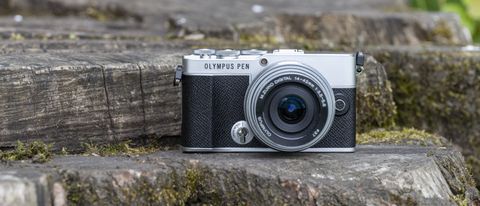TechRadar Verdict
The E-P7 blends stunning looks with a tried-and-tested engine, making it ideal for beginners and travel photography. The lack of a viewfinder may be a deal-breaker for some, while vloggers may be underwhelmed by its lack of video-centric specs. But if you're looking for a stills camera, the E-P7 is capable of producing results that are as beautiful as it looks.
Pros
- +
Attractive retro design
- +
Small and light
- +
Effective stabilization
Cons
- -
No viewfinder
- -
Pricier than E-M10 Mark IV
- -
Screen tilts underneath camera
Why you can trust TechRadar
Two-minute review
The Olympus PEN E-P7 is the first new camera from the brand since it was sold to new owners last year – and it draws on the spirit and specs of existing Olympus cameras to create a new travel-friendly mirrorless model.
We last saw an 'EP' camera all the way back in 2013, with the Olympus PEN E-P5. This is its spiritual successor, but with a similar engine to the Olympus OM-D E-M10 Mark IV from last year, it's a much more modern beast.
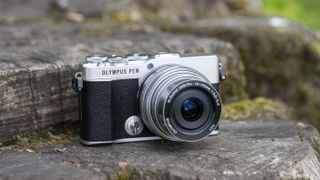
Price and release date
Design
Specs and features
Performance
Image and video quality
Should I buy it?
Full-frame sensors have very much been the spec du jour in recent years, but models like EP-7 show there is still some life in the smaller formats yet. You get a 20MP Four Thirds sensor plus a TruePic VIII processor – a combination that has proved successful in the past and produces results that certainly beat your smartphone.
The inclusion of a five-axis in-body image stabilization (IBIS) system also delivers up to 4.5 stops of compensation, something which is pretty unusual to find in such a small body. That makes it ideal for capturing handheld low-light shots, and perhaps more importantly for the one of the audiences Olympus is targeting: vloggers.
For vlogging, you get uncropped 4K/30p video, but you unfortunately don’t get a microphone or headphone input, which means you're restricted to either the built-in mic or a standalone one.
Now for the bad news on the photography front. While the E-P7’s internals are very similar to the OM-D E-M10 Mark IV, you miss out on an electronic viewfinder. The trade-off is a sleek and stylish body that weighs in at just 430g when used with the M.Zuiko Digital ED 14-42mm f3.5-5.6 EZ kit zoom, making it a very tempting option as one of the best travel cameras. But that may be deal-breaker for some photographers.

In practice, the E-P7 produces very nice images and some good quality video, too. Images are bright and punchy and display the same kind of dynamic range we’ve seen from previous Olympus offerings. The fact that it’s small enough to (almost) fit in your pocket, or to slip neatly into a bag with an additional lens or two, makes it more appealing than full-frame options for casual or street snapping.
The price is a problem, though. You can currently pick up the OM-D E-M10 Mark IV at a cheaper price, and that camera brings the added bonus of a viewfinder. Perhaps if you’re upgrading from a smartphone and don’t see the need for a viewfinder, that will be less of an issue, but for sheer value its stablemate is the better buy. Still, there's no doubt the E-P7 sure does look nice, and for some that may be more valuable than an EVF.
Olympus PEN E-P7 price and release date
- Available to buy now in Asia and Europe
- Black-and-silver or white-and-silver colorways
- Costs £749 body-only (around $1037 / AU$1,369)
As it stands, the Olympus PEN EP-7 will only be on sale in Asia and Europe, which means you can't currently buy it in the US or Australia.
This could be because the former two markets are the most receptive to travel-friendly mirrorless cameras, or it could be a case of testing the waters before releasing the camera to a wider audience. We'll update this page if there's any news about a wider release.
Right now, you can pick up the PEN E-P7 (body only) for roughly the same price as an Olympus OM-D E-M10 Mark IV with a kit lens. The E-P7 costs £749 body-only (around $1037 / AU$1,369), or £849 with the M.Zuiko Digital ED 14-42mm F3.5-5.6 EZ kit lens (about $1175 / AU$1550).
If you’re keen on having a viewfinder, the E-M10 Mark IV will be the better option. But if you’re after a camera that's as small and compact as possible, the E-P7 could be worth the extra outlay.



Design and handling
- Classic, retro design based on vintage film cameras
- Tilting screen, faces forwards underneath the camera
- Lots of control dials, touchscreen interface
The first thing to say about the E-P7 is just how attractive it is. Olympus has been producing beautifully-styled cameras for some time now, and the E-P7 very much follows that trend. If one of your key considerations when choosing a camera is how good it looks, then it ticks a lot of boxes.
Weighing just 430g (with the kit lens), it’s the ideal travel camera – or just for everyday, walk-around usage. On top of that, the kit lens retracts inside itself when not use, making it even more portable. It’s feasible to pop this in a jacket pocket, and it certainly won’t take up too much room in a small bag.
Of course, there’s always a sacrifice, and the trade off for having something so small and light is the lack of an integrated electronic viewfinder. If you’re using the camera for vlogging, that won’t be an issue. It’s also less likely to bother those who have stepped up from a smartphone and are used to composing their shots via a screen.
However, for a travel camera it has one major downside – in bright light, it’s much harder to compose your images via the screen, so at times it really is missed. An optional extra viewfinder can be added, but that’s an unnecessary expense when you could just buy the OM-D E-M10 IV in the first place.
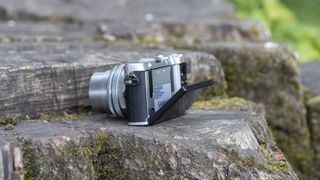
Going back to the screen, the touch-sensitive device tilts, rather than fully articulates. That’s helpful for composing from a number of different angles, but is less helpful for shooting portrait format images from up high or down low.
On the plus side, it faces all the way forward, so you can shoot handheld selfies and vlogs fairly easily. The bad news is that the hinge is at the bottom of the camera, so if you had plans to place the camera on a surface or a tripod while you film yourself talking to camera, you’ll be out of luck.
Despite the fact that the camera is small, there’s a small raised grip on the front of the camera, which is used in conjunction with a thumb rest on the back. The textured coating of the camera also helps it to feel secure and comfortable enough in the hand.
This is a camera that should appeal to both entry-level photographers and those who are more advanced. The mode dial on the top of the camera contains a range of beginner-friendly options such as automatic, scene and ‘art’ mode (for adding digital filters), and it’s easy to just pick it up and use it without much knowledge.
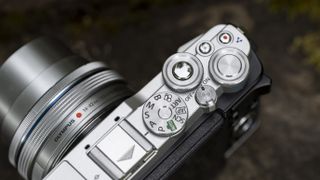
However, for those who want to go a bit further, you’ll also find advanced options on the mode dial, including semi-automatic and manual modes. The other two top dials can be used to adjust settings such as exposure compensation, shutter speed or aperture, depending on the mode you’re shooting in.
One minor complaint here is the slightly awkwardly placed on/off switch, which can be easy to knock to the 'off' position when making changes to the main mode dial, but it’s something you soon learn to account for when adjusting the dials.
The top dials work well in conjunction with the touchscreen functionality. A quick push of the 'OK' button on the back of the camera reveals a quick menu with a range of oft-used options to scroll through and quickly make changes, without requiring a deep delve into the more extensive main menu.
Olympus has always been keen on encouraging quick-fire creativity, and one such example is the useful switch on the front of the camera. This enables a quick move to 'Mono' mode, if you want to really go deep on that retro feeling that a camera like this inspires.
Specs and features
- 20.3MP Four Thirds Live MOS Sensor
- Built in five-axis sensor-shift image stabilization
- 4K/30p video recording
Although this is the first Olympus camera to be released under the brand's new OM Digital Solutions owners, it seems likely it was in development long before.
This is because it's heavily based on specifications from previous models. On the one hand, that makes it somewhat unexciting, but arguably when you have proven spec combinations, it makes sense to keep them.
The 20MP sensor has been in use by Olympus for some time now. This has proven to be a sensible resolution for a Four Thirds sensor, and the familiar combination with a TruePic VIII processor leaves you with something that's capable in a variety of shooting situations.
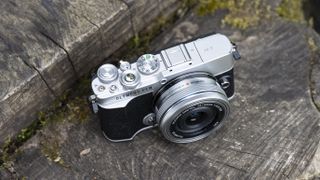
Although low-light shooting is typically not the forte of smaller sensors, the five-axis sensor shift image stabilization helps to keep ISO speeds low and gives you slightly longer handheld shutter speeds, which should produce cleaner results. As a travel-orientated camera, it’s also likely that you’ll primarily be shooting in good light, which makes its low-light credentials less of an issue.
The in-body image stabilization also helps when recording video. Here you get uncropped 4K, but it tops out at 30p. You can step up to 60p if you’re willing to drop down to Full HD. Although vloggers might be tempted by the small size and weight of the E-P7, the lack of a headphone and microphone socket, and the fact that the screen tilts from the bottom, probably don’t make it as appealing as other video-orientated cameras like the Sony ZV-1 and Panasonic GH5 Mark II.
Unless you already own lots of Micro Four Thirds lenses, it certainly makes sense to buy the E-P7 with the bundled 14-42mm kit lens. A good walk-around lens, primarily because of its ability to retract into itself to save space, it's part of a system that gives you access to a huge range of additional optics.
Whether you need an ultra wide-angle, a macro lens or a telephoto optic, there’s something available – and what’s more, Micro Four Thirds lenses are so small that you can pack a great travel setup with multiple options into a fraction of the space a full-frame equivalent would take up.
Performance
- 121-point Contrast AF system
- Up to 15fps burst shooting
- 360-shot battery life and USB charging
Just as we found in the OM-D E-M10 IV, the autofocusing system for the E-P7 doesn't set the world ablaze. But it is at least predictable, which is perfectly good enough for a camera of this type and size.
If you’re thinking of picking up the E-P7 for vlogging, the fact that it uses a contrast-detect autofocus system makes it less adept than the likes of the Sony ZV-1, which plumps for a hybrid phase/contrast detect system. Hybrid systems are generally quicker and sharper at sticking with subjects like faces.
If photography is your main concern, then the E-P7’s contrast-detect AF system puts in a perfectly good job. It locks on to the subject pretty quickly and easily, only struggling to acquire focus in extremely low light. A focus-assist lamp comes in handy in lower light conditions, though you may wish to switch that off in discreet settings.
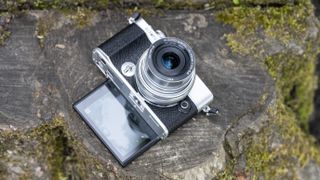
Photographing moving subjects is something that the camera can also handle, but it works best with ones that are moving at a fairly predictable, and not too rapid, pace. It’s also best to photograph subjects with a clean background, as tracking focus can sometimes struggle when busy scenes prove to be a distraction.
It’s also worth pointing out that the top shooting speed of 15fps, achievable in silent shooting mode, means that you’re less likely to turn to this for shooting sports - especially as to achieve that speed, focus will need to be fixed to the first frame.
The best results can therefore be found when sticking with AF-S and primarily shooting stationary – or at least relatively still – subjects.
Battery life is important for every camera, but particularly so for a travel-oriented one. The 360-shot battery life may not sound overly impressive on paper, but in practical use, the camera easily lasts a full day of stills shooting. It may last a little less if you’re consistently recording 4K video clips, though.
The good news is that the camera can be charged via USB (micro USB), so you can give it power bursts on the go if necessary (though it should be noted, it can’t be used while it’s being powered).
Image and video quality
- Impressive dynamic range
- Beautiful colors
- Good stabilization
It’s easy in this day and age to be put off by the size of Four Thirds sensors, but the E-P7 puts in a very solid performance and produces some lovely images.
If you’re looking to upgrade your travel snaps from those that you take on your smartphone, or perhaps a small-sensored compact, then you’ll likely be very pleased with the results the E-P7 is capable of producing.










It captures shots with an impressive dynamic range, while the all-purpose metering system does a good job of producing balanced exposures. That’s even the case when working in the harsh conditions of mid-afternoon sun in the middle of summer - in other words, typical travel photography conditions.
Away from good lighting conditions, you'll find that very high ISO shots are a little smudgy, especially if you examine darker areas at 100%. But you still get usable results up to around ISO 6400, particularly if you’re mainly sharing on social media sites. Having the five-axis image stabilization on hand is great for pushing handheld shooting, giving you scope to get away with using slow shutter speeds like 1/8th or even 1/4th of a second, and still get sharp results.
The kit lens puts in a good performance, too. For keeping your luggage as minimal as possible while traveling, it’s a great option. It gives you a decent amount of flexibility for zooming into scenes, while still giving you a wide enough (28mm equivalent) view to produce classic landscape scenes.
Video quality is good, and although it’s probably not going to attract the attention of dedicated vloggers, those who want to shoot the odd video clip will find it does a good job. Again, the image stabilization system works very effectively to help keep footage as smooth as possible – you can really see the difference when you switch it off.
Should I buy the Olympus PEN E-P7?
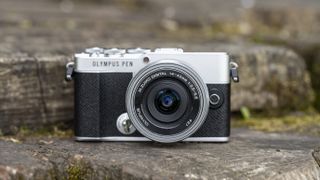
Buy it if...
You want one of the most stylish cameras around
The big selling-point of the E-P7 is its charming appearance, rather than its solid but unremarkable specs. It's important to own camera that you want to pick up and use regularly, so this is a legitimate factor to consider, particularly for beginners. The E-P7's retro charm, tactile dials and compact size make it a fun camera to use.
You mainly shoot stills, but want the option of video
Being small, light and travel-friendly might make the E-P7 seem like the obvious choice for vloggers. But it’s better to describe it as a stills camera that is good for the odd video. With specs that are now relatively ordinary for video – and no microphone or headphone jacks – photography is where it feels most at home.
You want a small, light camera with a big sensor
Thanks to its Four Thirds sensor, the E-P7 is a great step up from your smartphone. But because it lacks an electronic viewfinder, it's also pretty compact (if not quite pocketable). It's a lovely walk-around camera, while still offering manual modes and raw shooting for more advanced snappers.
Don't buy it if...
You need a camera with a viewfinder
Viewfinders are very much down to personal preference. Those who are used to them will certainly miss the absence of one here. They also come in extremely handy when shooting in bright, high-contrast situations, where the sun’s glare can make the screen difficult to see properly. If it’s likely to be a deal-breaker for you, check out the Olympus OM-D E-M10 IV instead.
You need a vlogging or YouTube camera
The E-P7's form factor might be attractive for vlogging, but its specs mean there are better options out there for shooting video. Its 4K video tops out at 30p, which is restrictive for those who want to shoot slower cut-scenes. A touchscreen that tilts down (behind the tripod mount) and the lack of headphone or microphone sockets mean its pretty average on the video front.
You're looking for the best value
By putting existing tech in a prettier body, Olympus is able to charge more money for the E-P7. Whether you think it’s a price worth paying is up to you – but if budget is your primary concern, you’ll get the same or similar results from cheaper models in the Olympus line up.
- These are the best travel cameras you can buy right now
Amy has been writing about cameras, photography and associated tech since 2009. Amy was once part of the photography testing team for Future Publishing working across TechRadar, Digital Camera, PhotoPlus, N Photo and Photography Week. For her photography, she has won awards and has been exhibited. She often partakes in unusual projects - including one intense year where she used a different camera every single day. Amy is currently the Features Editor at Amateur Photographer magazine, and in her increasingly little spare time works across a number of high-profile publications including Wired, Stuff, Digital Camera World, Expert Reviews, and just a little off-tangent, PetsRadar.

I always thought the DualSense Edge was too expensive to recommend, and now Sony has permanently dropped its price in the UK

Apple's AI headlines are more of a break from reality than breaking news

Alien: Romulus finally gets a Disney Plus release date three months after it landed on Hulu, and it'll be with us very soon
